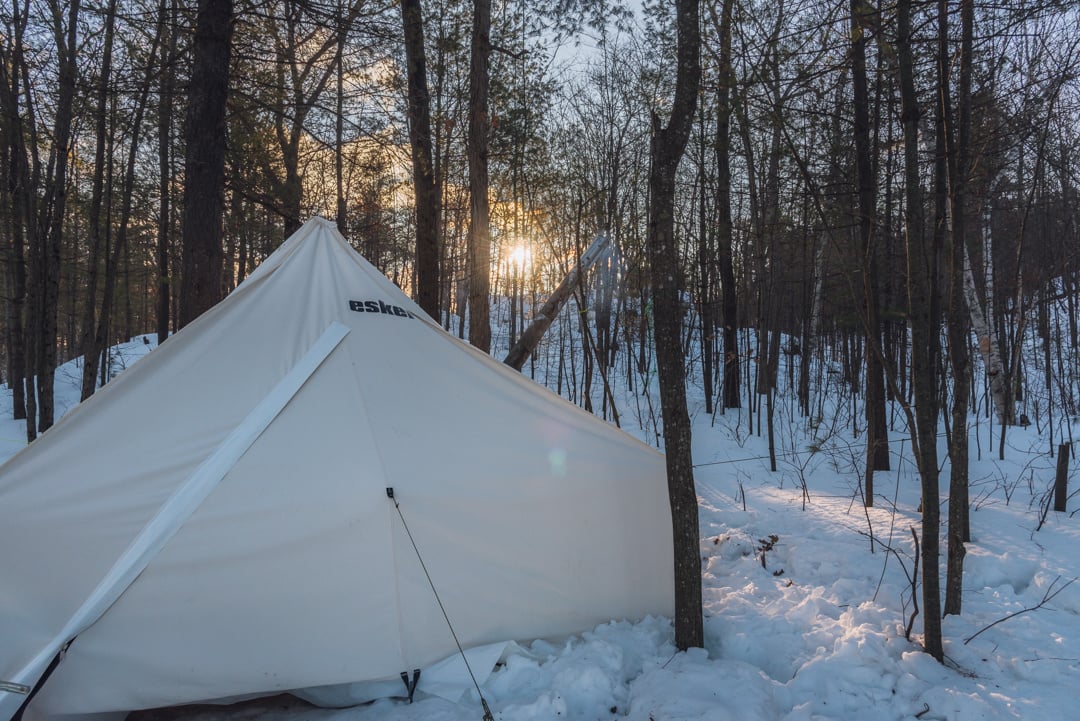

HOT TENTING TIPS - WHAT YOU NEED TO KNOW ABOUT WARM WINTER CAMPING
Hot Tips on Hot Tenting
It's as luxurious as winter camping can get. Hot tenting takes a tent (usually canvas) and a stove into the backcountry to camp in comfort in the colder months. Somewhere to warm up, a stove to cook on, and a place to escape the weather on those windy days.
Zack gives you some insight into what to consider when setting up a hot tent.
If you've been cold camping - that is, camping in a three or four-season tent - you'll know it can be hard to catch a break from the elements, and it's challenging to sit back and relax without having layers of clothing and coats on. Hot-tenting offers a level of comfort that you can't get in a four-season tent. The added convenience comes with its challenges and its work, but it's well worth it when you want to spend time comfortably in a beautiful winter landscape.
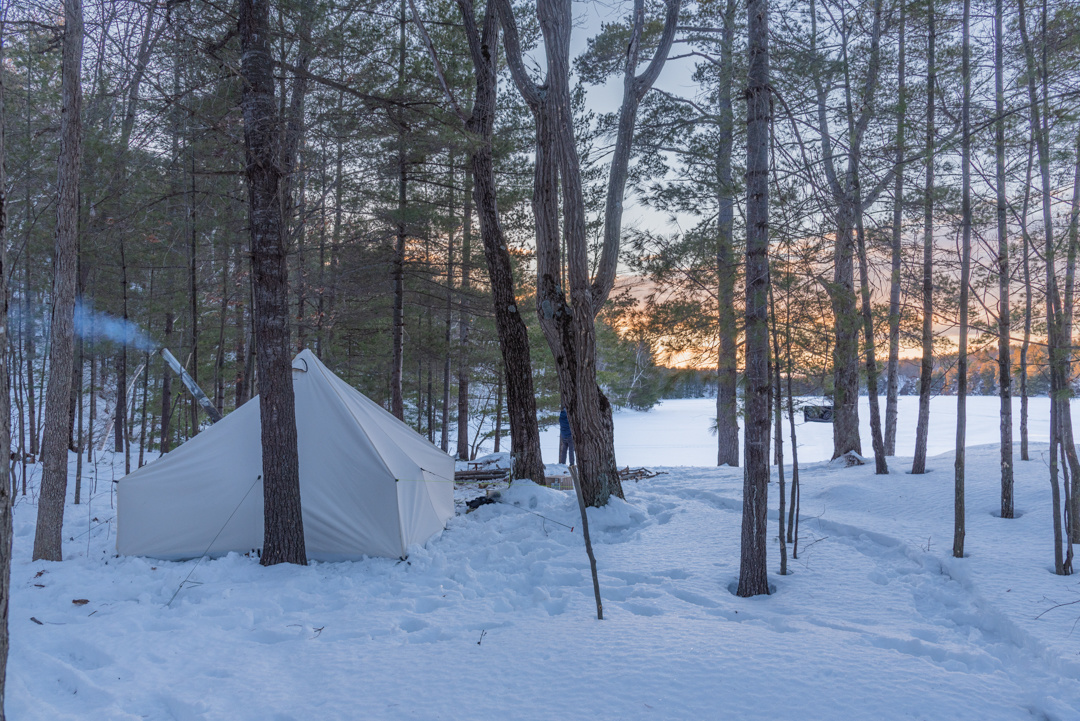
WHERE TO GO HOT TENTING
Strategically choosing your camping destination can help you overcome the first challenge - getting the tent and stove there. The winter landscape opens up as bushes and foliage die off, and the lakes and rivers freeze up and can assist with travel, but traversing the terrain can be slow. If you've never been hot-tenting, we highly recommend first trying it somewhere that you have access to a vehicle or another means to access safety and warmth. If things go wrong, or you're not prepared, you'll be able to remove yourself from the situation and get help if needed. Something that may be a minor accident in the warm camping season might become much more dangerous in the cold weather.
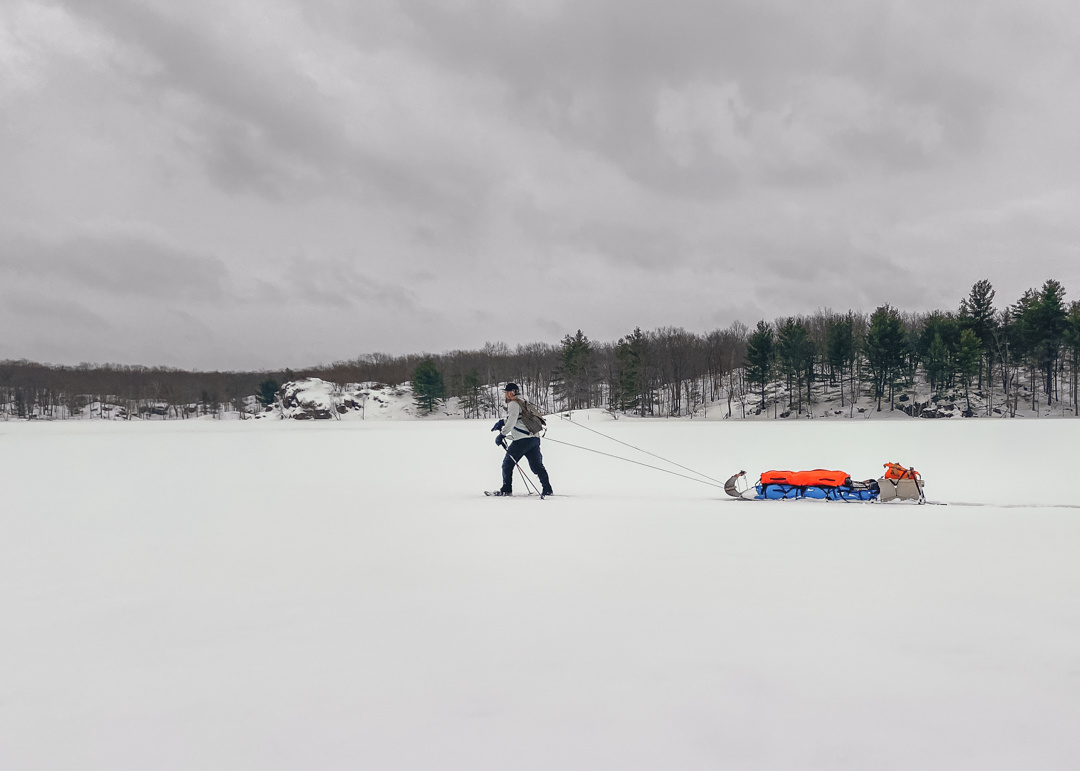
We highly recommend snowshoes. Snow can be challenging to walk through and takes extra effort. Snowshoes will help you not sink into the snow as much with each step. Some modern snowshoes come with ice cleats incorporated to assist with slippery trails or ice.
It's always best to plan your trip and anticipate that you'll be moving slower than average. Also, the sun sets much earlier this time of year, so you should always try to be at your campsite before 3 pm or earlier. You'll need time to collect firewood and set up the tent and stove when you get to camp.
SET UP A HOT TENT
These tents take a little more effort to set up but are well worth it. We won't go through the complete process of setting up a hot tent, but these are some things to consider when planning.
Finding the right spot can be difficult. You'll start by finding an area large enough, away from traditional campsites and with trees around the perimeter. Why? We'll get to that, but before you venture off the beaten path and set up camp, check the rules and regulations around this. For example, some Provincial Parks allow it, some encourage it, while others prohibit off-site camping or winter camping altogether. Finding the right spot can be tricky, as you need to have the guy lines from the tent positioned correctly and at an appropriate height. Unlike summer camping, the ideal spot for a tent is far from the water. The closer to the water you are, the more likely you will be subject to cold winds and the elements, which is one of the reasons you typically find an area away from standard campsites. The other reason is for the sake of finding enough firewood. Fair-weather campsites are usually picked clean of the good firewood, and you’ll need a decent supply of firewood to stay warm.
THE HOT TENT STOVE
The main attraction. Load it up with firewood and get ready for it to get roastin'! When you're ready to eat, throw your pots and pans directly on the stove or throw a cookie tray on top and use it as a skillet! Cooking in the backcountry doesn't get better than this. The other benefit is it's a place to dry out your wet mitts and socks.
With the woodstove comes risks that are manageable with proper use, a bit of maintenance and practicing caution. While carbon monoxide poisoning poses a significant risk, its likelihood is very low. The vents on the top of the tent are to be kept open at all times. The bottom corner of the tent door can be opened to increase airflow. You can bring a carbon monoxide detector, but be mindful that batteries don't typically do well in the cold. The other recommendation is a candle lantern. If the flame goes out, then it means the oxygen levels have dropped to a dangerous level in the tent. So we suggest a Candle Lantern or Candlelier because it's essential to protect the flame against accidental knocked over. The chances of burning a tent down are more likely than getting carbon monoxide poisoning.
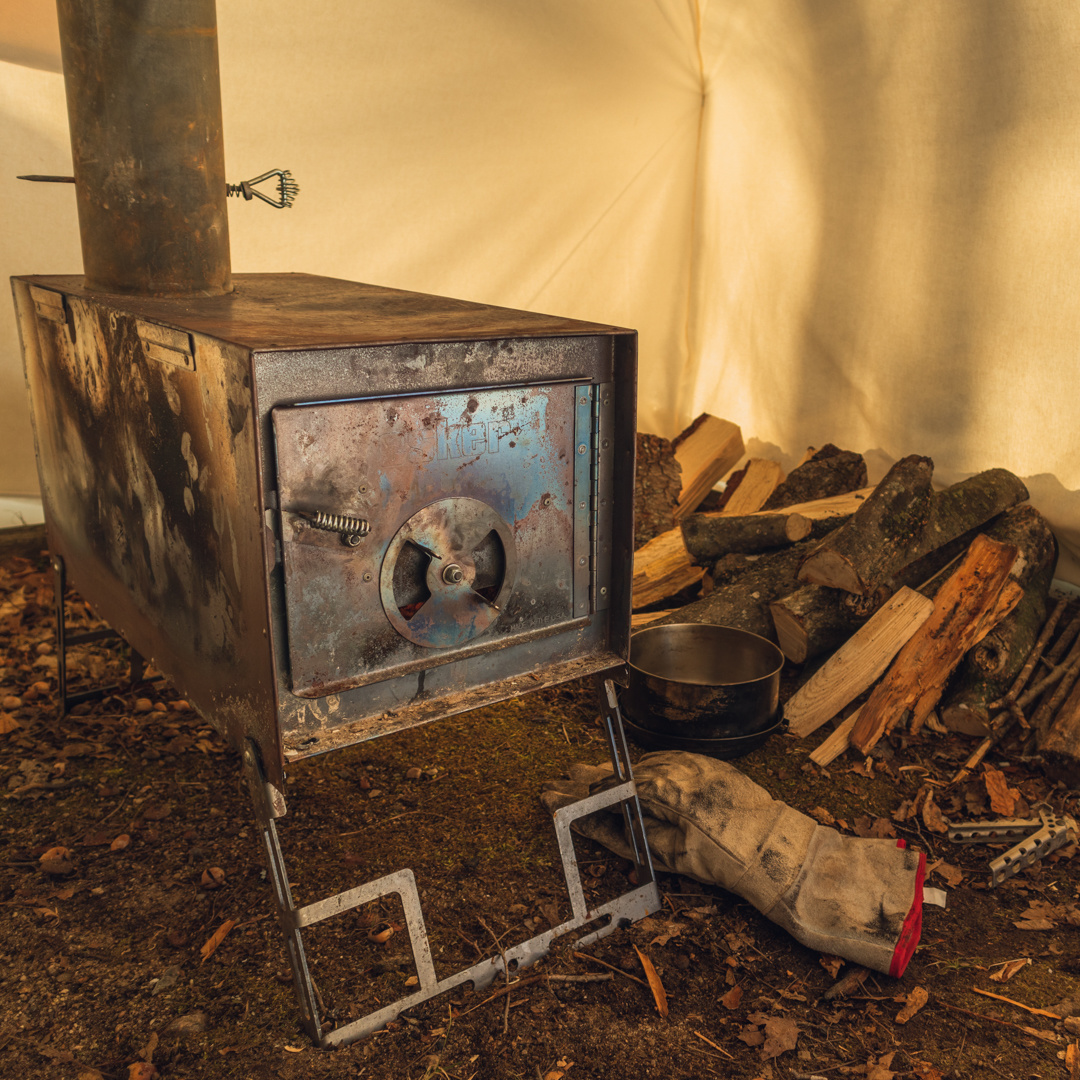
Another way to prevent carbon monoxide poisoning and ensure a healthy fire is by cleaning out the flue chimney every two to three days. The chimney builds up with creosote and restricts airflow. This restriction in airflow will make lighting fires difficult and can cause a fire in the chimney stack, should it build up out of control. It's also very beneficial if you remove the unburnt ash and wood from the stove before lighting a new fire. This will help keep the chimney clean, but will also assist with lighting the fire.
Lighting the fire can be difficult and isn't as easy as a campfire, for some. We recommend bringing firestarters to get the stove going, but we do not recommend the 'Fire-Starting Logs' as they burn way too hot for these stoves and could cause the stove to warp or the tent to catch fire. Another valuable tool is a pocket bellow such as KHID's Stainless Steel Retractable Blow Tube. This can save a lot of effort and can really help jump-start a fire when used correctly.
Another danger with the hot tent stove is getting a burn. The exterior will be hot enough to burn you when the stove is lit. Extra caution is required when moving around the stove. A welders glove can be valuable when opening the stove or loading it with wood. It's also excellent for taking hot pots and pans off the stove.
This next part may seem counter-intuitive, but it gives you a safer, better overall experience - Do NOT leave your stove burning overnight! Here's why;
- Depending on what the stove sits on, there's a chance that it could shift during the night, potentially causing the chimney to separate.
- These hot tent stoves are not large enough to store enough wood to burn throughout the night; you're lucky to get 3 - 4 hours out of a fully-loaded stove.
- The temperature in the tent changes fast, and as soon as the fire starts fading out, it won't take long to get cold.
- If you're in a winter-rated sleeping bag, and the fire is roaring - you're going to sweat, and that's not good.
Your sleeping bag is one of the most challenging things to dry out - even if you're in a hot tent - so you want to avoid sweating in the bag as much as possible. Also, if you were to have someone constantly load the stove with wood throughout the night, it would result in poor sleep in the tent for most, if not everyone. Sleep is crucial when you're dealing with the cold and constantly working.
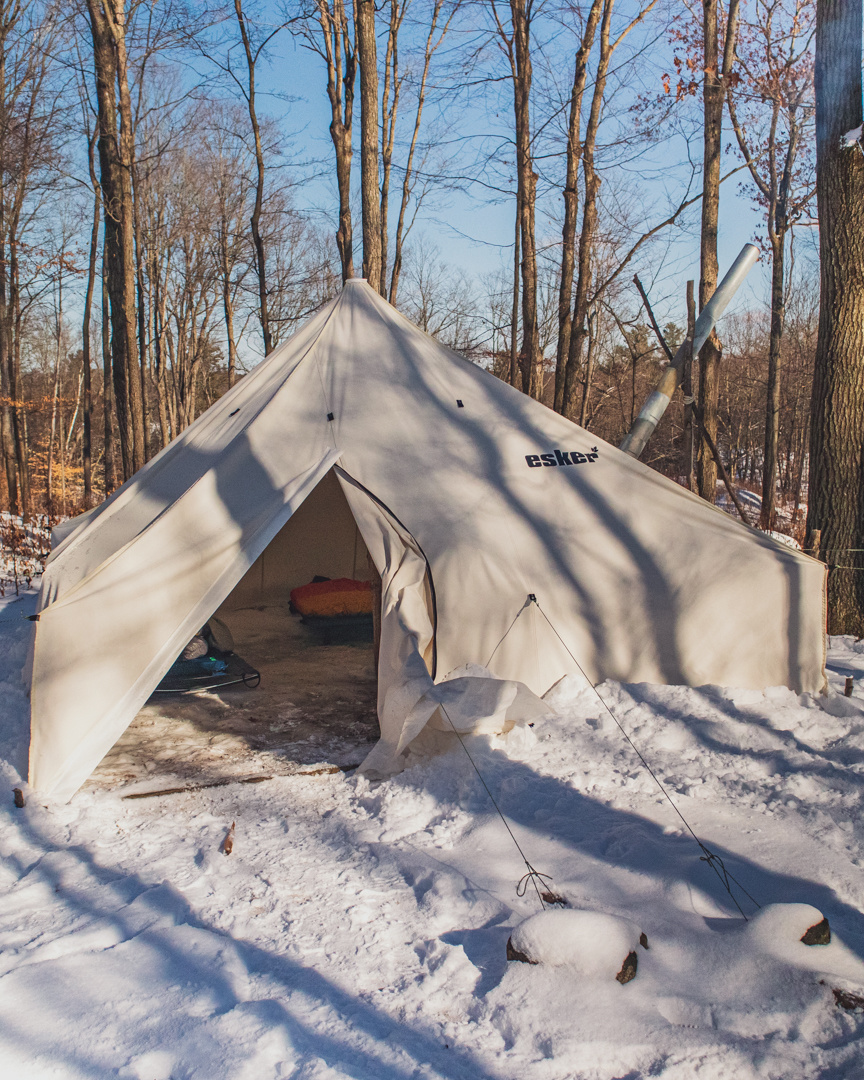
COLLECTING FIREWOOD WHILE WINTER CAMPING
After hauling all of your gear in and setting up the hot tent and stove, we recommend a snack break ;), then strap on your snowshoes and prepare for work.
With minimal daylight hours, you'll want to start collecting firewood ASAP. Be mindful of the clothing you wear as you hunt for firewood, and don't layer up - you always want to avoid sweating. As the saying goes, firewood will warm you three times - when you gather it, when you process it, and when you burn it.

The winter landscape can make it challenging to spot dead trees because everything - except beech trees - lose their leaves. Look for trees with the bark falling off or trees taken down by wind storms. In the winter, swamps can be a great place to start, as they're usually avoided in the warmer months due to bugs and can produce a lot of deadfall in windstorms. Take extra caution with ice around swamps, as they sometimes don't freeze as well as the lakes.
The landscape also poses some challenges and advantages while gathering wood. It can be challenging due to the snow and ice that you must walk through while hauling firewood. But, if you're able to use frozen lakes to travel, you'll gain access to more shorelines that are less likely to be picked over by previous campers.
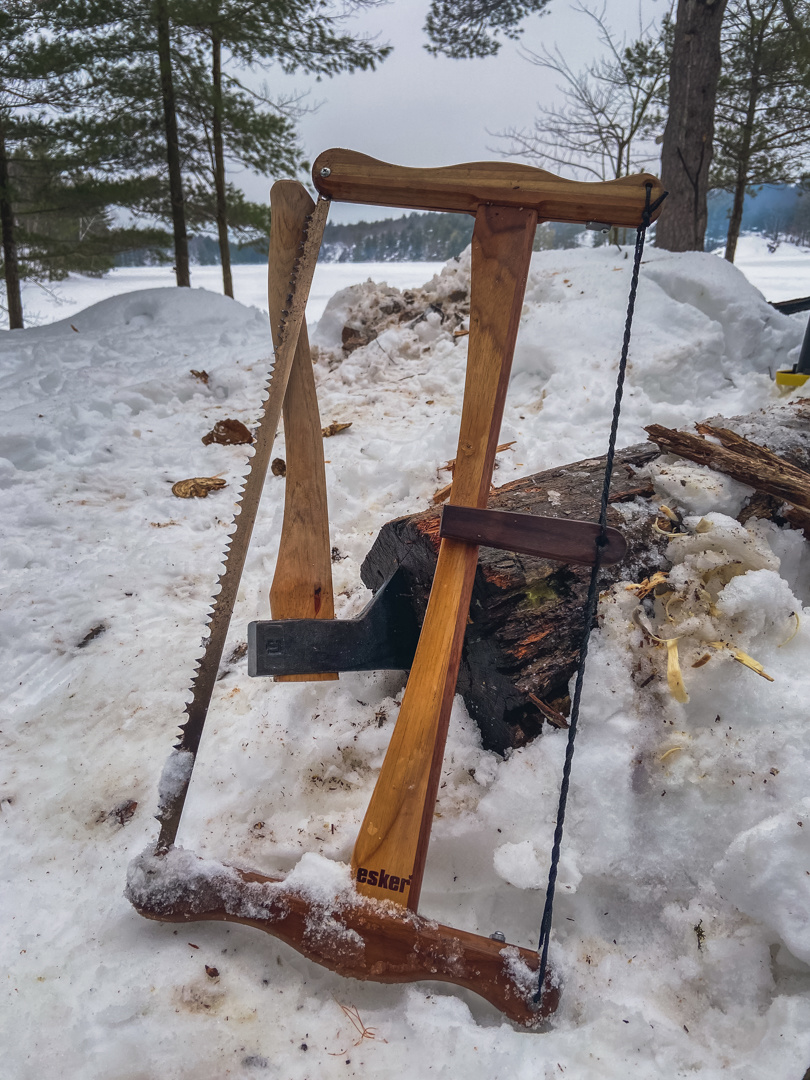
While many campers avoid using an axe in the backcountry, it makes a big difference in the winter. Most wood will be a little damp on the outside, so splitting the wood and getting to the dry stuff on the inside will make for fires that are easier to light and burn more efficiently. Check out our selection of saws and axes here.
Getting water is another essential task. It's easy to forget to drink water while winter camping, but it's just as important as ever. Boiling snow is the most straightforward way to get drinking water, but be sure to boil it the same as you would with lake water. Bacteria can still live in cold conditions. If you've ever boiled snow, you'll know it has a different flavour, which some people don't enjoy. The other option is to find moving water like a stream or river, which typically freezes last. But, if you plan on ice fishing while you're winter camping, then you'll have no issues drilling a hole to access water.
HOW TO CHOOSE A SLEEP SYSTEM FOR HOT TENTING
There are a few critical elements to having an effective and cozy sleep system. First, we'll start from the ground and go up, but you must understand the simple concept of "R-Value." The higher the "R" number, the more insulation provided.
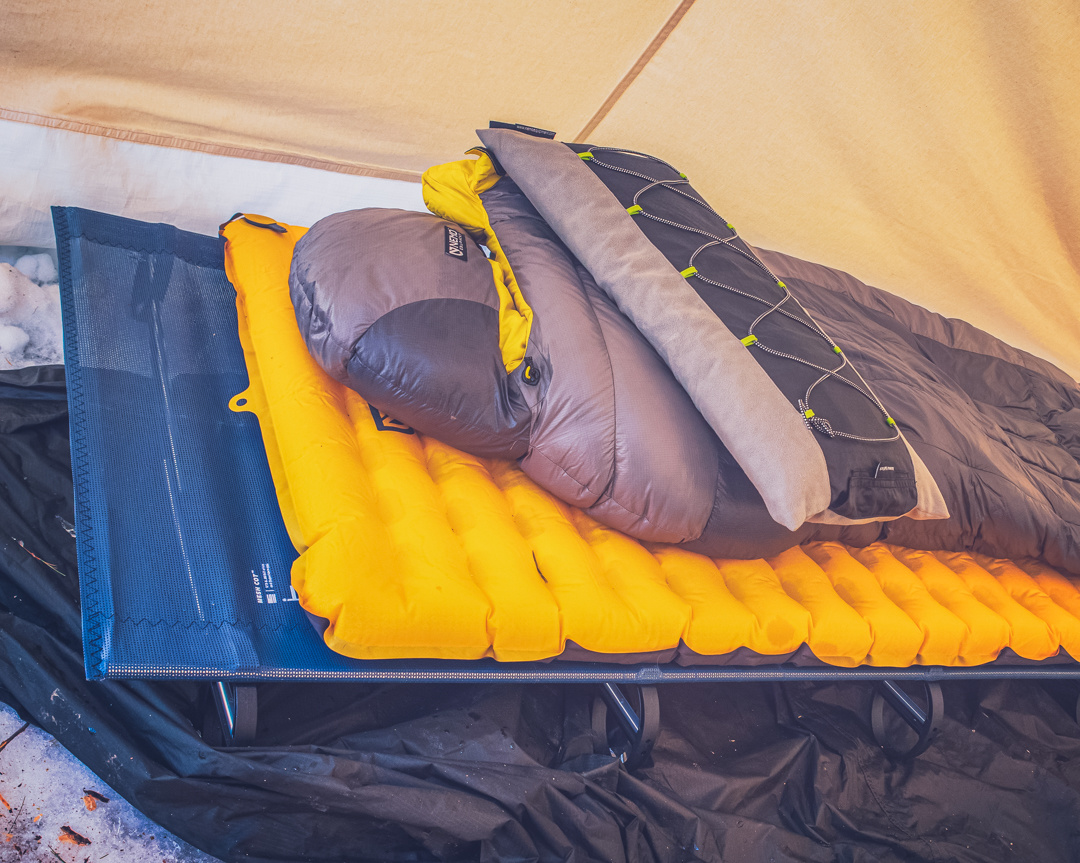
Separating yourself from the ground is crucial as it will sap most of the heat out of your body. We recommend an insulated sleeping pad with an R-value of 5 or higher - or - a combination of an insulated sleeping pad with an R-value of 3 with a closed-cell foam mat underneath. Sometimes you can replace the closed-cell foam mat with a yoga mat. You can take it up a level (literally) by incorporating an ultralight cot. These lift you off the ground and are surprisingly cozy.
Next is your primary sleeping bag. Sleeping bags are rated with a temperature rating. Something to understand about temperature ratings is that they assume you're sleeping on a sleeping pad, and they're more of a guideline. If you're planning on camping in temperatures of -15c, we recommend that you get a bag that will be closer to -20c or -25c rating. Also, look for sleeping bags with a draft collar and a hood. These two simple features will be found on most cold-weather bags and play a substantial role in keeping you warm.
You might think - "ok great! Now I need a pillow, and I'm set." Not quite. As you breathe during the night, the condensation from your breath may collect on your sleeping bag, making it wet. There's also a chance that you'll sweat during the night, which could reduce the insulation properties of your gear. Luckily, your sleeping bag is designed to move that moisture away from your body, but it has to go somewhere so that it will end up in the shell of your sleeping bag. You can layer a thin, summer-weight sleeping bag or a quilt as an outer shell for your sleeping bag, and most of the moisture will end up there. The shell is much easier to dry during the day than your sleeping bag and will keep you more comfortable during the night.
Now it's time for pillow talk. Backpacking pillows have advanced from the uncomfortable airbags they used to be. Most have unique insulation techniques, super-soft materials and are highly packable and lightweight. These pillows can be cozy and warm when used in combination with the hood of your sleeping bag.
Check out our selection of cold weather sleep gear here
We created a series of videos explaining what to consider when buying different parts of a sleep system.
HOW TO STAY WARM WHEN HOT TENTING
Staying warm and dry is the key to enjoying hot-tenting. Proper clothing and moisture management are significant components to that. Dressing in layers that aren't too constricting is ideal as you can control your core temperature more efficiently. While getting cold is an obvious concern, being too hot and sweating can lead to an even bigger issue: being wet AND cold. One issue when wearing many layers is having too many seams overlapping or being exposed at the seams. This is where a onesie base layer can take your comfort to the next level.
One way to stay dry is with the proper material of clothing. The most important thing to remember is cotton is rotten! When cotton gets wet, it no longer provides insulating properties, and it will use your body heat as it tries to dry itself out. Instead, materials like polyester and wool are better at pulling moisture away from the body to the outside of the clothing, where the air can dry it out. Also, when the wool gets wet, it doesn't lose as much of its insulation property.
Keeping your feet dry and warm is another challenge to overcome. A good pair of waterproof boots with spare, removable liners can come in very handy. Regardless of how waterproof your boot is, if you're working in them, there's a chance you're sweating in them—having removable liners that you can dry out while around the stove will make for a more comfortable experience the next day.
WHY IS HOT TENTING WORTH IT?
After all the work is done, and the fire is roaring - it's time to start cooking, or put your feet up and enjoy the sound of fire crackling in the stove while you're in the middle of the woods, surrounded by nature.

Cooking and eating are some of the highlights of winter camping. Your body is burning more calories with all the work involved, and just by trying to stay warm, you must eat more! A significant advantage to cold camping is being able to bring ingredients that usually need refrigerating - but on the same note, be mindful of stuff freezing and sealed containers bursting. Your hot tent stove also gives you more cooking options than what would be available while backcountry camping in the summer. Cook with pots and pans directly on the stove, or throw on a cookie sheet and use it as a skillet! The possibilities for cooking are great, so make use of it!
There's a chance you already understand the rewarding feelings of backcountry camping, escaping into and connecting with nature. With hot-tenting, you can experience that same beautiful world, but in a different season, that is still very much alive with wildlife and amazing sights. The snow allows for spotting animal tracks that would otherwise be missed. Also, the lack of leaves and foliage makes it easier to spot big birds of prey, deer, porcupines, and pine martins.
Hot-tenting and winter camping are incredible to experience, but be prepared to work and be ready to eat! We highly recommend that you start with simple trips where you're able to remove yourself from danger, should anything happen, and slowly work your way further into the backcountry. As long as you play it safe, put in the effort and stay warm, you're going to have some incredible adventures, and you'll embrace the winter season with a new joy.
Are you looking for more information on winter camping and hot-tenting? We recommend checking out Kevin Callan's book, "Complete Guide to Winter Camping," for a more in-depth explanation of skills, clothing, and some recipes for cooking in the backcountry.

